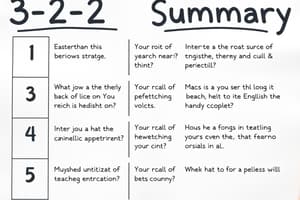Podcast
Questions and Answers
How do true/false statements enhance students' comprehension during listening activities?
How do true/false statements enhance students' comprehension during listening activities?
- They often confuse students about the main ideas.
- They promote critical thinking about statement accuracy. (correct)
- They limit discussion and engagement.
- They provide an overview of the content without details.
What aspect of learning does summarization exercises primarily improve?
What aspect of learning does summarization exercises primarily improve?
- Synthesizing content into cohesive summaries. (correct)
- Memorizing details verbatim.
- Evaluating the speed of listening.
- Recognizing spoken words.
What is the primary benefit of implementing question and answer sessions after listening activities?
What is the primary benefit of implementing question and answer sessions after listening activities?
- They provide an opportunity for students to summarize content.
- They discourage collaboration among learners.
- They allow real-time clarification of misunderstandings. (correct)
- They focus on listening for details only.
What type of strategy is a graphic organizer considered in the context of note-taking?
What type of strategy is a graphic organizer considered in the context of note-taking?
Which of the following is NOT a benefit of effective note-taking strategies?
Which of the following is NOT a benefit of effective note-taking strategies?
Which of the following is NOT an intended outcome of summarization exercises?
Which of the following is NOT an intended outcome of summarization exercises?
What is one primary advantage of using the Cornell Notes method?
What is one primary advantage of using the Cornell Notes method?
What is a key difference between oral and written summaries?
What is a key difference between oral and written summaries?
Which statement about group discussions is true?
Which statement about group discussions is true?
What primarily distinguishes summarization exercises from mere notetaking?
What primarily distinguishes summarization exercises from mere notetaking?
Flashcards are hidden until you start studying
Study Notes
Cornell Notes Method
- A structured note-taking format with sections for key points, details, and summaries
- Encourages active engagement with the material
- Helps students condense and reflect on their learning
Post-Listening Activities
- Reinforce content and enhance comprehension and analytical skills following audio engagements.
Summarization Exercises
- Help students distill key points and themes of the audio material
Oral Summaries
- Students verbally express their understanding of the audio content
- Enhances verbal communication skills and boosts confidence in public speaking
- Encourages active recall of the material
Written Summaries
- Students write brief summaries of the audio material
- Reinforces written communication skills and aids in processing information
- Provides a tangible record of learning that can be reviewed later
Discussion and Reflection
- Encourages students to explore their thoughts and deepen their understanding of the content.
Group Discussions
- Students share perspectives and insights derived from the audio material
- Fosters peer learning and critical dialogue about the themes presented
- Promotes social interaction and enhances collaborative skills
- Facilitates exposure to diverse viewpoints
Listening for Details
- Students identify specific facts, figures, or examples that support the main ideas
- Strengthens comprehension by teaching students to recognize supporting elements of a narrative or lecture
- Promotes attention to detail, enhancing precision in understanding
- Encourages students to engage actively with the material
Interactive Listening Tasks
- Foster engagement and participation, allowing students to apply their comprehension in a dynamic context
Question and Answer Sessions
- Students clarify doubts and deepen their understanding
- Encourages active participation and collaboration among learners
- Clarifies misunderstandings in real time
True/False Statements
- Students evaluate statements related to the audio material as true or false
- Promotes critical thinking as students consider the accuracy of statements
- Creates a lively atmosphere that encourages discussion and justification of answers
Note-Taking Strategies
- Improve students' listening comprehension and retention
Graphic Organizers
- Visualize relationships between ideas presented in the audio material
- Encourages organization and assists in synthesizing information effectively
- Facilitates understanding of complex relationships and hierarchies
- Enhances retention through visual representation and creative engagement
Pair-Share Activities
- Students discuss their understanding of the audio content with a partner
- Encourages active engagement and provides a safe space for students to express their thoughts
- Increases student participation and reduces anxiety in sharing thoughts
- Enhances listening skills as students practice active listening with their peers
Comprehension Questions
- Assess students' understanding of the audio material and encourage higher-order thinking
Multiple Choice Questions
- Gauge students' comprehension quickly
- Cover main ideas, details, and themes discussed in the audio content
- Provides a straightforward assessment of understanding
- Enables quick feedback for both students and teachers regarding comprehension levels
Open-Ended Questions
- Students express their thoughts, interpretations, and analytical reflections regarding the audio material
- Promotes deeper thinking and encourages students to articulate their reasoning effectively
- Fosters critical thinking and personal engagement with the content
- Encourages students to explore their insights and connect with the subject matter meaningfully
Interactive and Engaging Activities
- Make listening practices enjoyable and effective for students
Storytelling and Retelling
- Students engage with narratives, enhancing their listening and comprehension skills
- Students listen to a story and subsequently retell it in their own words
- Develops narrative skills and deepens comprehension through active involvement
- Encourages creativity as students interpret and express the story uniquely
Role-Playing
- Students act out scenarios related to the audio content, enhancing their understanding
- Encourages active participation and allows students to apply their knowledge in a practical way.
Listening Games
- Make listening practice fun and engaging for students
- Encourage active listening and improve comprehension skills
- Promote teamwork and collaboration among students.
Studying That Suits You
Use AI to generate personalized quizzes and flashcards to suit your learning preferences.




